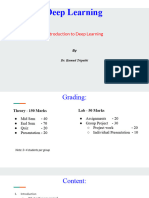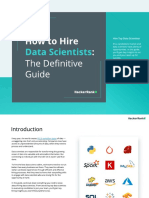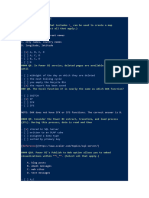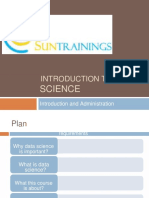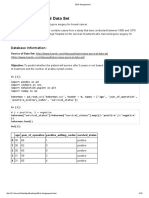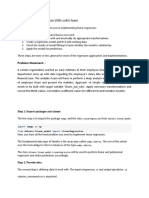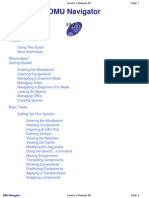DATA SCIENCE With DA, ML, DL, AI Using Python & R PDF
Uploaded by
Saikumar ReddyDATA SCIENCE With DA, ML, DL, AI Using Python & R PDF
Uploaded by
Saikumar Reddywith DATA ANALYTICS, MACHINE LEARNING,
DEEP LEARNING & ARTIFICIAL INTELLIGENCE
using PYTHON, R & Weka
INTRODUCTION TO DATA SCIENCE:
What is Data Science?
Who is Data Scientist and who can become a Data Scientist?
Real time process of Data Science
Data Science Applications
Technologies used in Data Science
Prerequisites knowledge to learn Data Science
INTRODUCTION TO MACHINE LEARINING:
What is Machine Learning?
How Machine will learn like Human Learning?
Traditional Programming vs. machine learning
Machine Learning engineer responsibilities
Types of learning
Supervised learning
Un-supervised learning
Machine learning algorithms: KNN, Naïve-bayes, Decision trees,
Classification rules, Regression (Linear Regression, Logistic Regression),
K-means clustering, Association rules, Support Vector Machine, Random
Forest.
PYTHON PROGRAMMING:
What is Python? History of Python
Python Features, Applications of Python
Downloading and Installing Python
Python IDE: Jupyter Notebook & Spyder
What is Anaconda Navigator?
Downloading and Installing Anaconda, Jupyter Notebook & Spyder
Python Programming vs. Existing Programming
Interactive Mode Programming & Script Mode Programming
Python Identifiers, Reserved Words
Lines and Indentations, Quotations, Comments
Assigning values to variables
DATAhill Solutions, Near Malabar Gold, KPHB, Hyderabad. Ph: 9292005440
Operators - Arithmetic Operators, Comparison (Relational) Operators,
Assignment Operators, Logical Operators, Bitwise Operators, Membership
Operators, Identity Operators
Decision Making and Loops
Flavors in Python, Python Versions
Data Types: int, float, complex, bool, str
List, Tuple, Range, Bytes & Bytearray
Set, Frozenset, Dict, None
Inbuilt Functions in Python, Slice operator - Indexing
Mutable vs. Immutable, Modules and Packages
Database Connection - PyMySQL, Defining & Manipulating
NumPy with Python:
NumPy Environment setup in Python, Features of NumPy
Array Creation, Indexing & Slicing, Array Manipulation
Mathematical Functions, Statistical Functions
Pandas with Python:
Pandas Environment setup in Python
Features of Pandas, Data Structures
Series - Create Series, Accessing Data from Series with Position
DataFrame - Features of DataFrame, Create DataFrame, DataFrame from
List, Dict, Row & Column Selecting, Adding & Deleting
Panel - Create and select data from Panel
Indexing & Selecting Data, Statistical Functions
Merging / Joining, Categorical Data
R PROGRAMMING:
R Programming Introduction
R Programming vs. Existing Programming
Downloading and Installing R, What is CRAN?
R Programming IDE: RStudio, Downloading and Installing RStudio
Variable Assignment - Displaying & Deleting Variables
Comments – Single Line and Multi Line Comments
Data Types – Logical, Integer, Double, Complex, Character
Operators - Arithmetic Operators, Relational Operators, Logical Operators,
Assignment Operators, R as Calculator, Performing different Calculations
Functions – Inbuilt Functions and User Defined Functions
STRUCTURES – Vector, List, Matrix, Data frame, Array, Factors
Inbuilt Constants & Functions
Setting Environment:
Search Packages in R Environment
Search Packages in Machine with inbuilt function and manual searching
Attach Packages to R Environment
Install Add-on Packages from CRAN
DATAhill Solutions, Near Malabar Gold, KPHB, Hyderabad. Ph: 9292005440
Detach Packages from R Environment
Functions and Packages Help
Vectors:
Vector Creation, Single Element Vector, Multiple Element Vector
Vector Manipulation, Sub setting & Accessing the Data in Vectors
Lists:
Creating a List, Naming List Elements, Accessing List Elements
Manipulating List Elements, Merging Lists, Converting List to Vector
Matrix:
Creating a Matrix, Accessing Elements of a Matrix
Matrix Manipulations, Dimensions of Matrix, Transpose of Matrix
Data Frames:
Create Data Frame, Vector to Data Frame
Why Characters are Converting into Factors? – stringsAsFactors
Convert the columns of a data frame to characters
Extract Data from Data Frame
Expand Data Frame, Column Bind and Row Bind
Merging / Joining Data Frames – Inner Join, Outer Join & Cross Join
Arrays:
Create Array with Multiple Dimensions, Naming Columns and Rows
Accessing Array Elements, Manipulating Array Elements
Calculations across Array Elements
Factors:
Factors in Data Frame, Changing the Order of Levels
Generating Factor Levels, Deleting Factor Levels
Loading and Reading Data:
DATA EXTRACTION FROM CSV
Getting and Setting the Working Directory
Input as CSV File, Reading a CSV File
Analyzing the CSV File, Writing into a CSV File
DATA EXTRACTION FROM URL
DATA EXTRACTION FROM CLIPBOARD
DATA EXTRACTION FROM EXCEL
Install “xlsx” Package
Verify and Load the "xlsx" Package, Input as “xlsx” File
Reading the Excel File, Writing the Excel File
DATA EXTRACTION FROM DATABASES
DATAhill Solutions, Near Malabar Gold, KPHB, Hyderabad. Ph: 9292005440
RMySQL Package, Connecting to MySql
Querying the Tables, Query with Filter Clause
Updating Rows in the Tables, Inserting Data into the Tables
Creating Tables in MySql, Dropping Tables in MySql
Using dplyr and tidyr package
STATISTICS:
Mean, Median and Mode
Data Variability: Range, Quartiles, IQR, Calculating Percentiles
Variance, Standard Deviation, Statistical Summaries
Types of Distributions – Normal, Binomial, Poisson
Probability Distributions, Skewness, Outliers
Data Distribution, 68–95–99.7 rule (Empirical rule)
Descriptive Statistics and Inferential Statistics
Statistics Terms and Definitions, Types of Data
Data Measurement Scales, Normalization
Measure of Distance, Euclidean Distance
Probability Calculation – Independent & Dependent
Hypothesis Testing, Analysis of Variance
DATA VISUALIZATION:
Data Visualization with MatPlotLib and Seaborn
Data Visualization with Graphics and GrDevices
High Level Plotting and Low Level Plotting
Pie Charts - Title, Colors, Slice Percentages, Chart Legend
3D Pie Charts
Box Plots - Outliers, Ranges, IQR, Quantiles, Median, Data Distribution
Analysis, 68–95–99.7 rule (Empirical rule)
Bar Charts - Label, Title, Colors, Group Bar, Stacked Bar Charts
Histograms - Range of X and Y Values
Line Graphs - Types: Points, Lines, Both, Overplotted, Steps
Scatterplots
Combining Plots - Par and Layout
LAZY LEARNING – CLASSIFICATION USING NEAREST NEIGHBORS:
Understanding Classification Using Nearest Neighbors
The KNN algorithm
Calculating distance
Choosing an appropriate k
Preparing data for use with KNN
Why is the KNN algorithm lazy?
Diagnosing breast cancer with the KNN algorithm
Collecting data
Exploring and preparing the data
o Transformation-normalizing numeric the data
DATAhill Solutions, Near Malabar Gold, KPHB, Hyderabad. Ph: 9292005440
o Data preparing –creating training and test datasets
Training a model on the data
Evaluating model performance
Improving model performance
o Transformation –z-score standardization
o Testing alternative values of k
PROBABILISTIC LEARNING – CLASSIFICATION USING NAÏVE
BAYES:
Understanding Naïve-Bayes
Basic concepts of Bayesian methods
Probability
Joint probability
Conditional probability with Bayes’ theorem
The Naïve Bayes Algorithm
The Naïve Bayes classification
The Laplace estimator
Using numeric features with Naïve Bayes
Filtering Mobile Phone Spam with the Naïve-Bayes Algorithm
Collecting data
Exploring and preparing the data
Data preparation –processing text data for analysis
o Data preparation –creating training and test datasets
o Visualizing text data-word clouds
o Data preparation-creating indicator features for frequent words
Training a model on the data
Evaluating model performance
Improving model performance
DIVIDE AND CONQUER – CLASSIFICATION USING DECISION TREES
AND RULES:
Understanding decision trees
Divide conquer
The C5.0 decision tree algorithm
o Choosing the best split
o Pruning the decision tree
Identifying risky bank loans using C5.0 decision trees
Collect data
Exploring and preparing the data
o Data preparation-creating random training and test datasets
Training a model on the data
Evaluating model performance
Improving model performance
o Boosting the accuracy of decision trees
o Making some mistakes more costly than others
DATAhill Solutions, Near Malabar Gold, KPHB, Hyderabad. Ph: 9292005440
Understanding classification rules
Separate and conquer
The one rule algorithm
The RIPPER algorithm
Rules from decision trees
Identifying poisonous mushrooms with rule learners
Collecting data
Exploring and preparing data
Training a model on the data
Evaluating model performance
Improving model performance
FORECASTING NUMARIC DATA – REGRESSION METHODS:
Understanding regression
Simple linear regression
Ordinary least squares estimation
Correlations
Multiple linear regressions
Predicting medical expenses using linear regression
Collecting data
Exploring and preparing data
o Exploring relationships among features- the correlation matrix
o Visualizing relationships among features –the scatter plot
matrix
Training a model on the data
Evaluating model performance
Improving model performance
o Model specification –adding non-linear relationships
o Transformation –converting a numeric variable to a binary
indicator
o Model specification –adding interaction effects
o Putting it all together-an improved regression model
Understanding regression trees and model trees
Adding regression to trees
Estimating the quality of wines with regression trees and model trees
Collecting data
Exploring and preparing the data
Training a model on the data
o Visualizing decision trees
Evaluating model performance
o Measuring performance with mean absolute error
Improving model performance
DATAhill Solutions, Near Malabar Gold, KPHB, Hyderabad. Ph: 9292005440
FINDING PATTERNS - MARKET BASKET ANALYSIS USING
ASSOCIATION RULES:
Understanding Association Rules
The Apriori algorithm for association rule learning
o Measuring rule interest –support and confidence
o Building a set of rules with the Apriori
Identifying frequently purchased groceries with association rules
Collecting data
Exploring and preparing the data
o Data preparation – creating a sparse matrix for transaction
data
o Visualizing item support –item frequency plots
o Visualizing transaction data-plotting the sparse matrix
Training a model on the data
Evaluating model performance
Improving model performance
o Sorting the set of association rules
o Taking subsets of association rules
o Saving association rules to a file or data frame
FINDING GROUPS OF DATA - CLUSTERING WITH K-MEANS:
Understanding Clustering
Clustering as a machine learning task
The K-means algorithm for clustering
o Using distance to assign and update cluster
o Choosing the appropriate number of cluster
Finding teen market segments using K-means clustering
Collecting data
Exploring and preparing the data
o Data preparation –dummy coding missing values
o Data preparing –imputing missing values
Training a model on the data
Evaluating model performance
Improving model performance
EVALUATING MODEL PERFORMANCE:
Measuring Performance for Classification
Working with classification prediction data in R
A closer look at confusion matrices
Using confusion matrices to measure performance
Beyond accuracy – other measure of performance
o The kappa statistic
o Sensitivity and specificity
o Precision and recall
o The F- measure
DATAhill Solutions, Near Malabar Gold, KPHB, Hyderabad. Ph: 9292005440
Visualizing performance TRADEOFFS
o ROC curves
Estimating future performance
The holdout method
Cross-validation
Bootstrap sampling
IMPROVING MODEL PERFORMANCE:
Tuning Stock Models for Better Performance
Using caret for automated parameter tuning
o Creating a simple tuned model
o Customizing the tuning process
Improving Model Performance with Meta – Learning
Understanding ensembles
Bagging
Boosting
Random forests
o Training random forests
o Evaluating random forest performance
DEEP LEARNING:
Installation of Theano, TensorFlow, Keras, OpenCV
Relating Deep Learning and Traditional Machine Learning
Basics of Neural Networks
Artificial Neural Networks
Deep Neural Networks
Convolutional Neural Networks
Recurrent Neural Networks
Deep learning with Theano
Deep Learning with TensorFlow
Deep Learning with Keras
Deep Learning with OpenCV
Implementation of Deep learning
ARTIFICIAL INTELLIGENCE:
AI Introduction
AI Intelligent Systems
AI Popular Search Algorithms
AI Fuzzy Logic Systems
AI Natural Language Processing
AI Robotics
AI Neural Networks
INTRODUCTION TO WEKA
EXPLORE WEKA MACHINE LEARNING TOOLKIT
DATAhill Solutions, Near Malabar Gold, KPHB, Hyderabad. Ph: 9292005440
Installation of WEKA
Features of WEKA Toolkit
Explore & Load data sets in Weka
PERFORM DATA PREPROCESSING TASKS
Apply Filters on data sets
PERFORMING CLASSIFICATION ON DATA SETS
J48 Classification Algorithm
Decision Trees Algorithm
K-NN Classification Algorithm
Naive-bayes Classification Algorithm
Comparing Classification Results
PERFORMING REGRESSION ON DATA SETS
Simple Linear Regression Model, Multi Linear Regression Model
Logistic Regression Model, Cross-Validation and Percentage Split
PERFORMING CLUSTERING ON DATA SETS
Clustering Techniques in Weka
Simple K-means Clustering Algorithm
Association Rule Mining on Data Sets
Apriori Association Rule Algorithm
Discretization in the Rule Generation Process
GRAPHICAL VISUALIZATION IN WEKA
Visualization Features in Weka
Visualize the data in various dimensions
Plot Histogram, Derive Interesting Insights
Trainer received Masters of Technology in Computer Science &
Engineering from JNTU, MICROSOFT Certified Professional, Certified
from IIT Kanpur & IIT Ropar.
Having 10+ Years of Experience in Software & Training.
His experience Includes Managing, Data Processing, Data Cleaning,
Predicting and Analyzing of Large volume of Business Data.
Expertise in Data Science, Data Analytics, Machine Learning, Deep
Learning, Artificial Intelligence, Python, R, Weka, Data Management &
BI Technologies.
Having publications and patents in various fields such as machine
learning, data security, and data science technologies.
Professionally, he is Data Science management consultant with over 7+
years of experience in finance, retail, transport and other industries.
DATAhill Solutions, Near Malabar Gold, KPHB, Hyderabad. Ph: 9292005440
Best training materials are provided with Lab Exercises, Data sets,
Codes, Quizzes, Case studies on real data.
For every online session Recorded video & live running notes will
provide.
Real time Training with live Scenarios and Applications.
Support in Resume preparation and Interview preparation.
Conduct Mock interviews through Skype and Telephonic after course
completion.
You can shift the batch to weekday batches (morning or evening) and
weekend batches.
Any number of batches can be attend in a year without any extra fees
Job support for 1 month after successfully placing the candidates.
Online help on Doubt Clearance, Career Guidance, Resume
Preparation and Interview Preparation.
DATAhill Solutions, Near Malabar Gold, KPHB, Hyderabad. Ph: 9292005440
You might also like
- Word2Vec Tutorial - The Skip-Gram Model Chris McCormick PDFNo ratings yetWord2Vec Tutorial - The Skip-Gram Model Chris McCormick PDF39 pages
- Data Science Course in Hyderabad - InnomaticsNo ratings yetData Science Course in Hyderabad - Innomatics10 pages
- Artificial Inteligence and Machine LearningNo ratings yetArtificial Inteligence and Machine Learning8 pages
- Data Science Terminology Flashcards - Quizlet100% (1)Data Science Terminology Flashcards - Quizlet15 pages
- AI (Artificial Intelligence) : Expert Systems Speech Recognition Machine VisionNo ratings yetAI (Artificial Intelligence) : Expert Systems Speech Recognition Machine Vision9 pages
- Difference Between Data Science and Machine LearningNo ratings yetDifference Between Data Science and Machine Learning5 pages
- Charotar University of Science and Technology Faculty of Technology and EngineeringNo ratings yetCharotar University of Science and Technology Faculty of Technology and Engineering10 pages
- Course Collections by Coursera - Machine Learning & Artificial Intelligence100% (2)Course Collections by Coursera - Machine Learning & Artificial Intelligence6 pages
- Intro To Career in Data Science: Md. Rabiul Islam100% (1)Intro To Career in Data Science: Md. Rabiul Islam62 pages
- AI - Instructional System Design (Final)No ratings yetAI - Instructional System Design (Final)25 pages
- Data Science Deep Learning & Artificial IntelligenceNo ratings yetData Science Deep Learning & Artificial Intelligence9 pages
- Purdue Data Science Master Program Slimupv2100% (1)Purdue Data Science Master Program Slimupv228 pages
- Machine Learning Complete-Course-Notes PolimiNo ratings yetMachine Learning Complete-Course-Notes Polimi107 pages
- Chapter 11: Business Intelligence and Knowledge Management: Oz (5th Edition)100% (1)Chapter 11: Business Intelligence and Knowledge Management: Oz (5th Edition)20 pages
- Building A Career in Data Science - The OverviewNo ratings yetBuilding A Career in Data Science - The Overview2 pages
- The Definitive Guide to Data Integration: Unlock the power of data integration to efficiently manage, transform, and analyze dataFrom EverandThe Definitive Guide to Data Integration: Unlock the power of data integration to efficiently manage, transform, and analyze dataNo ratings yet
- (M) BROCHURE - Digital Marketing Learning PathNo ratings yet(M) BROCHURE - Digital Marketing Learning Path27 pages
- PMS Integration and Energy Management Dashboard - StruxureWare Building Operation - Specification SheetNo ratings yetPMS Integration and Energy Management Dashboard - StruxureWare Building Operation - Specification Sheet4 pages
- Automatic Vehicle License Plate Recognition Using Optimal K-Means With Convolutional Neural Network For Intelligent Transportation SystemsNo ratings yetAutomatic Vehicle License Plate Recognition Using Optimal K-Means With Convolutional Neural Network For Intelligent Transportation Systems11 pages
- HP Festive OFFER 2020: WWW - Redeemnow.in/hpfestiveofferNo ratings yetHP Festive OFFER 2020: WWW - Redeemnow.in/hpfestiveoffer12 pages
- TROVIS 6400 Automation System TROVIS 6493 Compact ControllerNo ratings yetTROVIS 6400 Automation System TROVIS 6493 Compact Controller8 pages
- Module II: Programming in C: Amity School of Engineering and TechnologyNo ratings yetModule II: Programming in C: Amity School of Engineering and Technology100 pages
- Connecting Excel To ControlLogix - PLCdevNo ratings yetConnecting Excel To ControlLogix - PLCdev9 pages
- Project Manager IT Software Development in Houston TX Resume Joetta NevelsNo ratings yetProject Manager IT Software Development in Houston TX Resume Joetta Nevels2 pages
- E-Way Bill System: User Manual For Tax PayersNo ratings yetE-Way Bill System: User Manual For Tax Payers56 pages
- Cisco Meraki SD-WAN v2 - Instant Demo: About This DemonstrationNo ratings yetCisco Meraki SD-WAN v2 - Instant Demo: About This Demonstration13 pages
- Hadoop Vs Spark Vs Kafka - Comparing Big Data & Distributed Streaming ToolsNo ratings yetHadoop Vs Spark Vs Kafka - Comparing Big Data & Distributed Streaming Tools4 pages
- Embedded I/O Modules: Leverage Proven Design Technology at A Lower CostNo ratings yetEmbedded I/O Modules: Leverage Proven Design Technology at A Lower Cost3 pages



